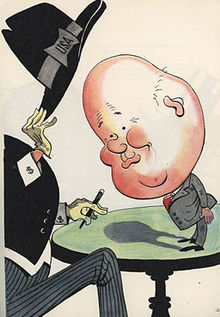De-Stalinization
De-Stalinization is the way that the Soviet Union tried to undo Joseph Stalin's politics and the heroic image he created of himself using propaganda. After Stalin died, a group led the Soviet Union for a while. Georgi Malenkov was the Premier of the Soviet Union; Lavrentiy Beria, head of the Ministry of the Interior; and Nikita Khrushchev was First Secretary of the Central Committee.
Because Stalin had so prominent a control over the Soviet Union, he was placed on a pedestal both at home and among communists abroad. In the years 1953–1955, a period of "silent de-Stalinization" took place, as the revision of Stalin's policies was done in secret, and often with no explanation.
Revisionism[change | change source]
In 1954, Nikita Khrushchev became the leader of the Soviet Union. He attempted to reform the Soviet government and change how socialism in the country should be run. In order to do this, he had to change the way the public thought of Stalin, this is called revisionism. He removed Stalin's corpse out of the mausoleum in Red Square[1] and he changed the name of Stalingrad (which was named after Stalin) to Volgograd.[2] Some people disliked Khrushchev’s reform and those who oppose revisionism are called anti-revisionist.

References[change | change source]
- ↑ CNN Interactive - Almanac - October 31, CNN,
(October 31) 1961, Russia's de-Stalinization program reached a climax when his body was removed from the mausoleum in Red Square and re-buried.
- ↑ Reuters (1961-11-11), "Stalingrad Name Changed", The New York Times,
MOSCOW, Saturday, Nov. 11 (Reuters) -- The "Hero City" of Stalingrad has been renamed Volgograd, the Soviet Communist party newspaper Pravda reported today.
{{citation}}:|author=has generic name (help)
